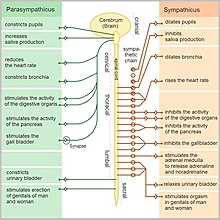| Dysautonomia | |
|---|---|
| Other names | Autonomic failure, Autonomic dysfunction |
 | |
| The autonomic nervous system | |
| Specialty | Neurology |
| Symptoms | Anhidrosis or hyperhidrosis, blurry vision, tunnel vision, orthostatic hypotension, constipation, diarrhea, dysphagia, bowel incontinence, urinary retention or urinary incontinence, dizziness, brain fog, exercise intolerance, tachycardia, vertigo, weakness and pruritus.[1] |
| Causes | Inadequacy of sympathetic, or parasympathetic, components of autonomic nervous system[2] |
| Risk factors | Alcoholism and Diabetes[3] |
| Diagnostic method | Ambulatory Blood pressure, as well as EKG monitoring[better source needed][4] |
| Treatment | Symptomatic and supportive[2] |
Dysautonomia, autonomic failure, or autonomic dysfunction is a condition in which the autonomic nervous system (ANS) does not work properly. This may affect the functioning of the heart, bladder, intestines, sweat glands, pupils, and blood vessels. Dysautonomia has many causes, not all of which may be classified as neuropathic.[5] A number of conditions can feature dysautonomia, such as Parkinson's disease, multiple system atrophy, dementia with Lewy bodies,[6] Ehlers–Danlos syndromes,[7] autoimmune autonomic ganglionopathy and autonomic neuropathy,[8] HIV/AIDS,[9] mitochondrial cytopathy,[10] pure autonomic failure, autism, and postural orthostatic tachycardia syndrome.[11]
Diagnosis is made by functional testing of the ANS, focusing on the affected organ system. Investigations may be performed to identify underlying disease processes that may have led to the development of symptoms or autonomic neuropathy. Symptomatic treatment is available for many symptoms associated with dysautonomia, and some disease processes can be directly treated. Depending on the severity of the dysfunction, dysautonomia can range from being nearly symptomless and transient to disabling and/or life-threatening.[12]
- ^ Cite error: The named reference
emedwas invoked but never defined (see the help page). - ^ a b "Dysautonomia Information Page | National Institute of Neurological Disorders and Stroke". www.ninds.nih.gov. Retrieved 2 January 2018.
- ^ "Dysautonomia | Autonomic Nervous System Disorders | MedlinePlus". NIH. Retrieved 2 January 2018.
- ^ Cite error: The named reference
patwas invoked but never defined (see the help page). - ^ Cite error: The named reference
nihwas invoked but never defined (see the help page). - ^ Cite error: The named reference
Palma2018was invoked but never defined (see the help page). - ^ Castori M, Voermans NC (October 2014). "Neurological manifestations of Ehlers-Danlos syndrome(s): A review". Iranian Journal of Neurology. 13 (4): 190–208. PMC 4300794. PMID 25632331.
- ^ Imamura M, Mukaino A, Takamatsu K, Tsuboi H, Higuchi O, Nakamura H, Abe S, Ando Y, Matsuo H, Nakamura T, Sumida T, Kawakami A, Nakane S (February 2020). "Ganglionic Acetylcholine Receptor Antibodies and Autonomic Dysfunction in Autoimmune Rheumatic Diseases". Int J Mol Sci (Review). 21 (4): 1332. doi:10.3390/ijms21041332. PMC 7073227. PMID 32079137.
- ^ McIntosh RC (August 2016). "A meta-analysis of HIV and heart rate variability in the era of antiretroviral therapy". Clin Auton Res (Review). 26 (4): 287–94. doi:10.1007/s10286-016-0366-6. PMID 27395409. S2CID 20256879.
- ^ Kanjwal K, Karabin B, Kanjwal Y, Saeed B, Grubb BP (October 2010). "Autonomic dysfunction presenting as orthostatic intolerance in patients suffering from mitochondrial cytopathy". Clinical Cardiology. 33 (10): 626–629. doi:10.1002/clc.20805. ISSN 1932-8737. PMC 6653231. PMID 20960537.
- ^ Cite error: The named reference
pmid38692780was invoked but never defined (see the help page). - ^ Iodice V, Kimpinski K, Vernino S, Sandroni P, Fealey RD, Low PA (June 2009). "Efficacy of immunotherapy in seropositive and seronegative putative autoimmune autonomic ganglionopathy". Neurology. 72 (23): 2002–8. doi:10.1212/WNL.0b013e3181a92b52. PMC 2837591. PMID 19506222.